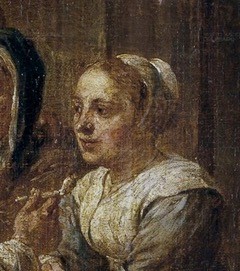From Emigrants’ Daughter to Landed Matriarch, 1641-c. 1730
Margrietje (Margaret) Cosyns, AKA Grietje Gerrits, was baptized in the New Amsterdam Reformed Dutch Church on May 5, 1641. She was the first child of Cosyn Gerritsen van Putten and his wife Vroutje, who had arrived in New Amsterdam in around 1636 from the province of Gelderland. Often a challenge to these parents, Grietje Cosyns’ go-getting spirit turned out to be perfectly suited to the challenges of life on the frontier that was New Amsterdam.
 Soon after their arrival, Cosyn received a land grant for about 68 acres in the neighborhood of Washington Square Park today. He was a wheelwright, a trade most necessary in a community that increasingly depended on wagons, carts, and wheelbarrows for its existence. On old maps is a road marked “Cosyn Gerritsen’s Wagon Way” leading to his workshop.
Soon after their arrival, Cosyn received a land grant for about 68 acres in the neighborhood of Washington Square Park today. He was a wheelwright, a trade most necessary in a community that increasingly depended on wagons, carts, and wheelbarrows for its existence. On old maps is a road marked “Cosyn Gerritsen’s Wagon Way” leading to his workshop.
Like most settlers ambitious to succeed in the primitive landscape that was New Amsterdam in the 1630s, Cosyn supplemented his income by dabbling in real estate, selling some of the free land he had acquired in his grant and buying with the proceeds a house or two for rental purposes. By these means he was able to provide a livelihood for his growing family that supplied, besides the necessities of life, also some relative luxuries, perhaps fur hats or taffeta petticoats for the ladies of the household?
Nothing is known of the childhood of Grietje (“little Margaret”), except that it was probably carefree and even idyllic in the bucolic village on the island of Manhattan. But in April 1654, at the age of thirteen, still a child herself in modern thought, she married. Marriage for females in Dutch law allowed girls to wed at age twelve. But few took advantage of this provision. One historian who has looked at the known slender facts of Grietje’s life described her as “precocious.”
Upon marrying Herman Theuniszen van Zell, a young German farmer from Munsterlandt, Grietje received a dowry consisting in part of acreage carved out of her father’s land in the Out Ward, adjacent to the bouwerie, or farm, of Director General Petrus Stuyvesant. According to the law at the time, Grietje’s land legally belonged to her husband, but Grietje, in the entrepreneurial spirit of the day, planted crops on it, selling the surplus for an income for herself and her family.
Concerning this land, Grietje appears in the public records of the court of New Amsterdam in August 1656. A horse belonging to a neighbor, one Hendrick Pietersen, ran away and got into Grietje’s buckwheat field, where it trampled her nearly ripened cash crop. Furious, she jumped on the horse and rode him bareback to the Collect, a fresh-water pond near today’s Center Street, an area then surrounded by swamps and dense virgin forest, and left him there, no doubt with a smart slap to his flank. His owner, equally furious, took her to court and demanded that she find the animal and return it to him. Grietje’s feisty nature made itself known at this point. She promptly went to court, calling on neither her father nor her husband to plead her case, which was customary at the time, but defending herself. The court listened to both plaintiff and defendant and found for Grietje, ordering Hendrick to pay her for the ruined buckwheat and to find his own horse himself.
Herman died, date unknown, and in 1662 at age twenty-one, resilient Grietje married again. Her second husband was Jan Pietersen Haring, also a wheelwright, an emigrant in about 1660 from Hoorn in the province of North Holland. By this time New Amsterdam’s population was growing so fast that Grietje’s father, Cosyn Gerritsen, needed a partner to handle the overflow in the wheel-making business. The union is recorded in an old family Bible declaring that it was the first marriage performed in the newly built chapel on Petrus Stuyvesant’s bouwerie in the Out Ward.
Jan and Grietje had seven children between the years 1664 and 1681, all but one of whom was baptized in the Reformed Dutch Church of New York. The one whose baptism is not found was their first child, Pieter, born in the very confusing week in August 1664 when English warships appeared in the waters off the Battery and demanded that the Colony of New Netherland and its principal city, New Amsterdam, surrender to the King of England.
The terms of the surrender were not harsh, and under English rule the Dutch continued to flourish. But Jan Pietersen Haring had a dream notwithstanding. In 1681, he became the leader of a group of friends and neighbors to acquire from the Tappaen Indians in today’s Rockland and Bergen counties 16,000 acres. Here, the families would farm, build a courthouse and a church, and govern themselves away from the English in New York. This became known as the Tappan Patent.
That spring, Jan and Grietje and their seven children, four sons and three daughters, set to work clearing the land, building rudimentary housing (said to be pits dug in the ground lined with bark and protected from the elements with thick branches), and planting the crops that when harvested and processed would feed them through the winter to follow. It was harsh, demanding, and exhausting work, but it was their dream, and they were determined to realize it. Alas, Jan Pietersen Haring died unexpectedly at age fifty-one, before the family had a chance to settle in on the Patent, leaving Grietje with seven children, five under the age of fourteen.
Her resilient nature showed itself again. She soon married a third time, to a neighbor in the Out Ward, widower Daniel de Clark, thirteen years her junior.
One third of Grietje’s now sizable property became Daniel de Clark’s property, according to the law. Her children received one third, and she retained the third third. In 1700, DeClark, a brewer, built a handsome brick house in Tappan for Grietje and himself. General George Washington made it his headquarters on three occasions during the Revolutionary War. It still stands.
Grietje lived to be around ninety years of age and at her death left scores of descendants to marvel at her life from emigrants’ daughter to matriarch of a large and successful family numbering in the hundreds then and in the millions today. Still, it was a man’s world, and it should be noted that Grietje’s progress in it was furthered by men and male authorities throughout.
Along the way, church baptismal records reveal that she served as witness to at least five children of freed African slaves baptized in the New York Reformed Dutch Church. That three of the thirteen Patentees in the Tappan Patent were also people of color indicates that relations between the races in New Amsterdam were not only cordial, but close and cooperative. This would change when English rule strengthened.
We hope you’ve enjoyed our articles and information. If you would like to contribute to help us promote and spread the history of the early New York, please click and discover more about our programs, what we offer and ways you can help.
To be a sponsor email us at: events@newamsterdamhistorycenter.org




